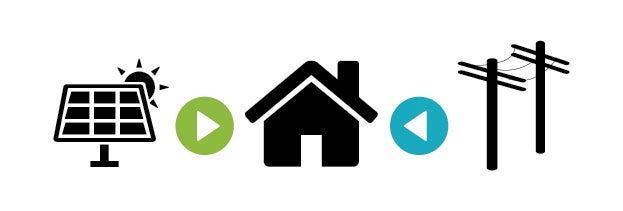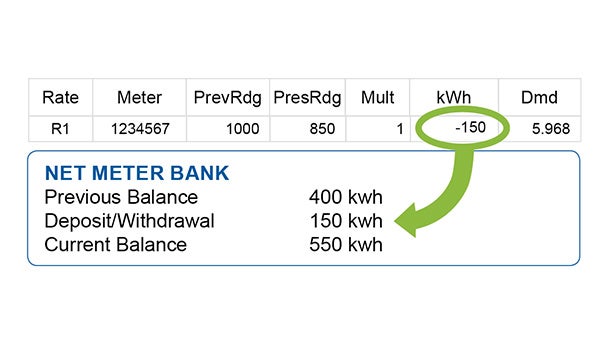The Grid and Your Solar System
By installing solar panels at your service location, you become an independent generator of electricity. Under a net metering agreement with United Power, you also benefit from grid access when you produce more power than you use. As a net metered customer, you can be a net-user, a net-generator, or you can be completely reliant on the United Power system for your power — all depending on the production of your system.
Net User

Your home will use all the energy produced by your solar system before going to the United Power system for additional power. Whenever your home pulls power from the United Power system, that energy is recorded on the delivered channel of your net meter. The delivered channel represents what power your home needed after using all available solar energy and is not a measurement of your home’s total energy consumption.
Net Generator

When you are producing more energy than your home needs, your excess energy goes back to the United Power system. That “leftover” amount is reflected on the received channel of your meter. The received channel of your electric meter does not record the total production of your solar system, rather it tells you how much excess power you had after your home used all the available solar generated power.
System Power

If your solar system is not generating any power, your home will pull 100 percent of your power needs from the United Power system. Any power pulled from the United Power system is recorded on the delivered channel of your meter and reflected as an Energy Charge on your bill.
Settlement of Your Net Meter Bank
Your net meter energy bank balance will continue to roll over each month until March of each year when all net meter energy banks are settled and returned to a zero balance. All net meter bank balances are paid out at the current wholesale energy rate.
If you have a balance in your net meter bank, you can have your balance applied as a bill credit to your April bill to help offset future service and energy charges.
Online Account Resources
Members can quickly view net energy data online via SmartHub Billing & Payment Portal or the Power Portal.
SmartHub Billing & Payment Portal: View daily usage information, view and pay bills and make account updates.
Power Portal: The Power Portal provides in-depth interval data to help you analyze your energy consumption. The Power Portal data can be exported for further analysis with your solar production data.
As a United Power member with a net meter agreement, your bill looks a bit different because you consume both the energy produced by your solar electric system and the energy you receive from United Power. When you produce more energy than you use, you receive credit for that energy through an energy banking process listed on your bill as your Net Meter Bank. Your current bank balance is printed on your monthly bill.
Adding to Your Bank

When you generate more energy than you use in a month, a negative meter reading will print on your bill, and a “deposit” will be made to your net meter bank. Your net meter bank balance continues to grow as long as you produce more energy than you use each month.
Making a Withdrawl

If you use more energy than your system produces, United Power will “withdraw” energy credits from your net meter bank before you are assessed any energy charges. Energy used in excess of your net meter bank balance will appear as an energy charge in your billing detail.
Billing Detail Line Items
Energy Charge is any energy used from the United Power system above what your system generated. If you had excess generation for that month, your energy charge is zero, and your excess generation was “deposited” into your net bank. If you used more energy than you generated, your net meter bank is depleted before you are assessed energy charges.
Demand Charge is the highest 15-minute interval of consumption from the United Power system over the billing period measured in kilowatts (kW) and multiplied by the per kW rate.
Fixed Charge a fixed monthly charge to cover a portion of the costs for billing, collections, member services, and metering. These are costs that are incurred by all members regardless of the amount of energy used.
Franchise Fees/Sales Taxes depending on where you live, you may be charged a city fee based on a percentage of your monthly electric usage and you may be subject to local and state taxes. United Power does not make a profit on the collection of these fees and taxes. They are passed through from the customer to the appropriate jurisdiction.
Demand charges are applied to all rate classes, including those with solar panels on a net-metering agreement. Through a net-metering agreement, you can connect your system to the grid to return any excess power from your system and then tap into it anytime your system isn’t generating enough energy to meet your needs. This grid access adds tremendous value to your solar investment. Without it, you would have to invest in additional storage and generating equipment, rely on alternative fuel sources and significantly alter your energy use habits. So, whether you use a lot of energy, or just a little, we all need a reliable distribution system to be there. The demand rate ensures that all members pay their fair share of the system’s operating and maintenance costs.
Solar or the Grid
Members with solar panels can reduce energy charges by shifting electric consumption to peak generating periods, but unless you go completely off-grid, there will still be a peak interval during the billing period where you rely on the distribution system for co-op power. For example, a member could generate solar as a negative energy consumer from about 8 a.m. to about 3 p.m. Later that the evening, their energy use could exceed their production and they will begin using co-op power to supplement their needs. This member would continue using energy from the grid into the evening hours and eventually hit their demand of 8kW at 7 p.m.
Saving on the Demand Rate
Recommendations to manage demand are the same for all members. Since demand is driven by the amount of power required at once, staggering the use of major appliances is the easiest way to keep demand charges low. Your peak consumption may not always align with the peak output of your solar generating system, and you are most likely going to hit your demand when you operate appliances at night, or when solar generating conditions are not optimal.

